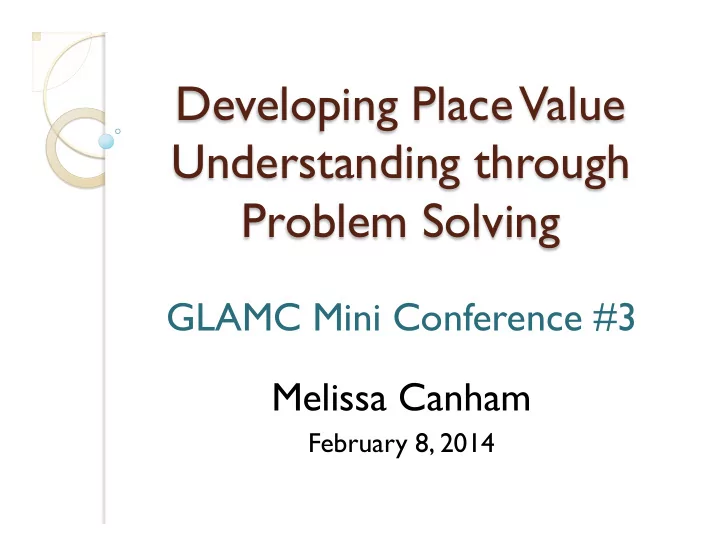

Developing Place Value Understanding through Problem Solving GLAMC Mini Conference #3 Melissa Canham February 8, 2014
WHERE IS PLACE VALUE IN THE CCSS? K 1 2 3 4 5 6 7 8 HS Counting & Cardinality Ratios and Proportional Number and Operations in Base Ten Relationships Number & Quantity Number and Operations – The Number System Fractions Expressions and Equations Algebra Operations and Algebraic Thinking Functions Functions Geometry Geometry Statistics & Measurement and Data Statistics and Probability Probability
Focus Areas in Support of Rich Instruction and Grade Expectations of Fluency and Conceptual Understanding Addition and subtraction K-2 concepts, skills, and problem solving, and place value Multiplication and division of whole numbers 3-5 and fractions concepts, skills, and problem solving Ratios and proportional reasoning; early expressions and 6 equations Ratios and proportional reasoning; arithmetic of rational 7 numbers 8 Linear algebra and linear functions
What is the end goal? 4 th grade Narrative from the CCSS-M: ◦ Students generalize their understanding of place value to 1,000,000, understanding the relative sizes of numbers in each place. They apply their understanding of models for multiplication (equal-sized groups, arrays, area models), place value, and properties of operations, in particular the distributive property, as they develop, discuss, and use efficient, accurate, and generalizable methods to compute products of multi-digit whole numbers (CCSS-M, p.27)
Where do we start? K.NBT.1: Compose and decompose numbers from 11 to 19 into ten ones and some further ones, and record each composition or decomposition by a drawing or equation; understand that these numbers are composed of ten ones and one, two, three, four, five, six, seven, eight, or nine ones.
What does Cognitively Guided Instruction (CGI) Look Like? Problem solving is the focus of instruction; teachers pose a variety of problems Many problem-solving strategies are used to solve problems. Children decide how they should solve each problem. Children communicate to their teachers and peers how they solve the problems. Teachers understand children’s problem-solving strategies and use that knowledge to plan instruction.
Counting Collections
Counting Collections In groups of 2-3, take one bag of items. Your task is to count the collection of items in that bag in any way that makes sense to you. After you count your collection, try to record on your paper what and how you counted. Leave your items on your tables exactly as you counted them.
1 st Grade Counting Collections -- October
STANDARDS OF MATHEMATICAL PRACTICE 2. Reason abstractly and 1. Make sense of problems and persevere in quantitatively Reasoning and explaining 3. Construct viable arguments and critique the reasoning of others Overarching 4. Model with mathematics habits of mind Modeling and of a productive 6. Attend to precision using tools 5. Use appropriate tools mathematical strategically thinker solving them 7. Look for and make use of Seeing structure structure and generalizing 8. Look for and express regularity in repeated reasoning
Looking at Student Work What similarities and differences do you notice? If you have seen these collections in your classroom, what mathematics do students demonstrate understanding of in this task? How might you be able to help students who struggle?
Debrief: Counting Collections How does this support understanding of place value? What possible benefits do you see for students to engage in this type of task? When might this be a good task to pose to students? How do we help students think about what they are doing (meta-cognition) and provide structure to developing these skills?
Grouping by 10 Word Problems
Groups of Ten Strategies Direct Modeling by Ones Direct Modeling by Tens Counting by Ones and/or Tens Direct Place Value
Looking at Strategies Solve the following problem two different ways. Our class has 7 boxes of doughnuts. There are 10 doughnuts in each box. We also have 3 extra doughnuts. How many doughnuts do we have all together?
What Strategy? A (3, 1)
What Strategy? B (3, 1)
What Strategy? C (7, 3)
What Strategy? D (12, 4)
What Strategy? Bailey’s Strategy: “The answer is in the number choices. For (3,1), it is 31 because you have 3 tens and 1 one. For (7, 3) it is 73. For (12, 4) the answer is 124 because you have 12 tens and 4 ones.”
Developing Understanding of Place Value Unitizing the ten (or hundred or thousand) in context Constructing meaningful solutions without instruction Providing many experiences with grouping by ten facilitates children’s invention of multi-digit algorithms.
Kevin Video How did Kevin solve the problem? What type of strategy did he use? Did Kevin’s strategy surprise you?
Number Talks
What is a Number Talk? 5 – 15 minutes during the opening of math time Short lesson alongside (but not necessarily directly related to) the ongoing math curriculum Provide students with meaningful ongoing practice with: ◦ Computation ◦ Number Sense ◦ Place Value ◦ Standards for Mathematical Practice ◦ Listening to others’ strategies ◦ Properties of Operations
What does Cognitively Guided Instruction (CGI) Look Like? Problem solving is the focus of instruction; teachers pose a variety of problems Many problem-solving strategies are used to solve problems. Children decide how they should solve each problem. Children communicate to their teachers and peers how they solve the problems. Teachers understand children’s problem-solving strategies and use that knowledge to plan instruction.
CGI Website www.dusd.net/cgi
Thank You! mcanham@dusd.net www.dusd.net/cgi
References Jaslow, L.B and Jacobs, V.R. “Helping Kindergarteners Make Sense of Numbers to 100.” The Journal of Mathematics and Science . Vol 2, 2009. Parrish, Sherry. Number Talks . Math Solutions, 2010 Schwerdtfeger, Julie and Chan, Angela. “Counting Collections.” Teaching Children Mathematics. March, 2007.
Recommend
More recommend